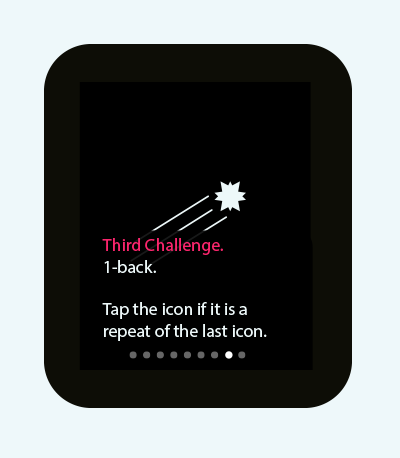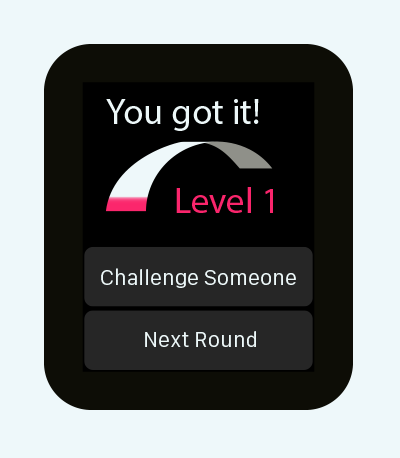Created by Emerson Dameron, Lindsey Rosenfield, and Alec Strandberg, in collaboration with Coder[EXP]

Meet Bob
Bob is a twenty seven year old software engineer. He’s incredibly tech savvy and a big Apple fan. He prides himself on being part of the cutting edge of technology, so it was only natural that Bob purchased an Apple Watch the very first day they were publicly sold. He’s been enjoying the process of exploring his new device for a few months now, but that honeymoon period is starting to wane and he’s interested in finding more practical uses for his watch. He’s tried some productivity and brain training apps, but the small screen size makes them difficult to use and most are just pared down versions of iphone apps. He’s downloaded a few games, even though he typically doesn’t play them, but they drained his battery quickly and were frustrating to play on the watch interface. It’s frustrating for Bob that a device so convenient to use is being used for so little.

Bob Meets SPAN
SPAN is one of the first IOS games designed with apple watch use first and foremost. Using SPAN Bob can challenge his friends to a back and forth battle of wits. Based on peer-reviewed psychological tasks, SPAN allows Bob to simultaneously compete with and improve his short term memory.
Starting at Rank 1, Bob challenges his friends to short, ~1 minute rounds in which his working memory is put to the test.
Use Cases and User Value
1. In meetings
Like most focused people, Bob gets distracted by certain parts of large business meetings that aren't relevant to his work. Pulling out a tablet wouldn't go over well, but no one should be bothered if he peeks at his Watch for a few seconds to keep a game going. He can see how he stacks up with the important people in his live or even engage in a furtive, productive battle of wits with the guy across the table. (Note: Team SRD nor its affiliates assume any responsibility for Bob's professional conduct.)
2. On the train
Bob lives in a major U.S. city and takes mass transit to work. Trains are crowded during rush hour, but whether he's seated or holding a strap, a quick interaction with his Watch and a taste of intellectual competition (‘fiero’) tickles Bob's brain for just long enough to keep him awake.
3. During conversations
Bob is too polite to use large mobile devices when talking to his friends in person. But when there's a lull, or when he and his friends are waiting in line or break off into smaller groups, Bob can get a quick shot of confidence with a momentary glance at his Watch.
Bob is too polite to use large mobile devices when talking to his friends in person. But when there's a lull, or when he and his friends are waiting in line or break off into smaller groups, Bob can get a quick shot of confidence with a momentary glance at his Watch.
4. Cooking
When Bob cooks meals, he's often in hurry-up-and-wait mode. A watched pot never boils, but the right Apple Watch game provides a nice, encouraging break that keeps him active without pulling him out of the cooking process. And it certainly won’t drain too much precious battery life.
When Bob cooks meals, he's often in hurry-up-and-wait mode. A watched pot never boils, but the right Apple Watch game provides a nice, encouraging break that keeps him active without pulling him out of the cooking process. And it certainly won’t drain too much precious battery life.

Design Principles
1. Limit gameplay to burst micro-interactions of 10-30 seconds
The Apple Watch is not easy to use for long stretches. If the periods of gameplay are any longer than 30 seconds at the most, the game is better suited for mobile. However, if it's limited to small bursts at a time, a game can fit right in with typical Watch use cases.
2. Take advantage of the Apple Watch's unique features
The ideal Watch game makes elegant use of the platform's key features, thus plugging into the excitement around the device and taking on the shape of its container.
3. Minimal UI
Apple Watch screens are small. Complex interactions don't work. The more clean and simple the interface, the more successful the game.
4. Make the game feel productive
To capture the interest of early adopters, don't create a “time-waster.” Create something challenging, psychologically rewarding, and quick enough to leave them wanting more.
5. Conserve time and power
An overwhelming majority of Apple Watch users are conscious of the device's relatively short battery life. Protracted, graphically heavy applications will likely give them the sense that their Watches are being drained. Create something that obviously doesn't ask too much of the Watch's battery supply.
6. Asynchronous Multiplayer
Like most people, Apple Watch users do have “free time” - it's just parceled out into small, unpredictable increments. Asynchronous matches, along with the ability to take on friends or strangers, gives them the power to play whenever they want.
7. Don’t make me hunt
The Apple Watch users we surveyed spoke highly of notifications, but weren’t interested in spending much time tracking down new apps or browsing the Watch interface. Because of the way SPAN challenges work, players get a buzz, get in, and get out quickly.

Game-play In Depth
Each round consists of one or more complex span tasks.
The player is given a challenge. Before each new challenge, they are shown a single green square from a 4x4 grid. This is a ‘mine’ square, and they will need to remember its location. This repeats anywhere from 3 to 5 times, with the length/difficulty of these cognitive load tasks increasing each round.
After this they are shown a 4x4 grid with a start and end point marked in pink. They are tasked with drawing a line between those two squares without touching any of the ‘mine’ squares. If they can do this, they have completed the round. (In later rounds, as difficulty intensifies, they may have to remember mine locations for multiple, separate grids, which they will complete one after another at the end of the task.)
Players start at Round One, which is a short tutorial level designed to introduce each “minigame,” or type of challenge Each minigame is explained, as is the overarching round system. Each completed round elevates the player’s rank and moves him on to the next round.
After successfully completing a new round, the player has the power to challenge another player to take on that round. If the second player accepts and beats the round, he can challenge the first player to the next round. This process repeats until one player fails. Players are ranked according to the highest round they have ever successfully completed.
Players can challenge other players of any rank, but can only begin challenges at the rank of the lowest-ranked player involved in the challenge.
A leaderboard will display the player’s rank compared to those of friends, others in the player’s region, and the overall playerbase. You can select individual players on the leaderboard to see your record against them in challenges. To preserve space on the Watch screen, the full leaderboard can only be seen on a connected mobile device.


Breaking New Ground Together
What makes an early adopter? What separates a typical user (someone who waits until a product is fully fleshed out and part of the mainstream) from someone who wants to start on page one, to be part of the product's journey from the beginning? An early adopter is excited to be present in the moment.
An early adopter loves the fast pace of technological innovation and wants to be part of it. Thus, early adopters give vital support to companies that ship early and ship often.
The Apple Watch is a platform in its infancy. SPAN is a product designed for the unique needs of its current unique user base, with an eye toward its future.
SPAN is a fun and challenging little game that fits right into the current Apple Watch landscape. But let's think long-term for a moment...
The early adopters who play SPAN now will sense that they are part of something special in its crucial early stages. Research indicates that SPAN players will return to the game to maintain the skills and status it helps build and to increase their threshold of gratification. Players can grow with SPAN, SPAN can grow with the Apple Watch platform, and users and stakeholders can break new ground together.



